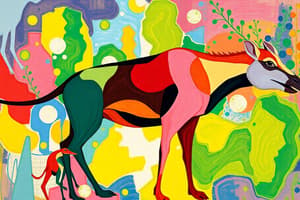Podcast
Questions and Answers
Tous les animaux sont autotrophes et produisent leur propre nourriture.
Tous les animaux sont autotrophes et produisent leur propre nourriture.
False (B)
Les arthropodes sont un groupe majeur d'invertébrés.
Les arthropodes sont un groupe majeur d'invertébrés.
True (A)
La reproduction asexuée chez les animaux implique la fusion de gamètes.
La reproduction asexuée chez les animaux implique la fusion de gamètes.
False (B)
Les animaux possédant des poumons utilisent uniquement leur peau pour la respiration.
Les animaux possédant des poumons utilisent uniquement leur peau pour la respiration.
Les mollusques font partie des phylums d'animaux vertébrés.
Les mollusques font partie des phylums d'animaux vertébrés.
Tous les animaux vertébrés possèdent un squelette interne.
Tous les animaux vertébrés possèdent un squelette interne.
Les poissons sont classés parmi les mammifères.
Les poissons sont classés parmi les mammifères.
Tous les animaux jouent un rôle dans leur écosystème comme producteurs, consommateurs ou décomposeurs.
Tous les animaux jouent un rôle dans leur écosystème comme producteurs, consommateurs ou décomposeurs.
Les reptiles et les amphibiens sont des classes de vertébrés qui se reproduisent principalement par des œufs.
Les reptiles et les amphibiens sont des classes de vertébrés qui se reproduisent principalement par des œufs.
Les herbivores sont des animaux qui se nourrissent de matières organiques en décomposition.
Les herbivores sont des animaux qui se nourrissent de matières organiques en décomposition.
Flashcards
Vertébrés
Vertébrés
Les animaux qui ont un squelette interne, un système nerveux complexe et une colonne vertébrale.
Consommateurs
Consommateurs
Les animaux qui se nourrissent d'autres organismes pour leur énergie.
Rôle écologique
Rôle écologique
Le rôle qu'un animal joue dans son écosystème, par exemple producteur, consommateur ou décomposeur.
Clé dichotomique
Clé dichotomique
Signup and view all the flashcards
Pollinisation
Pollinisation
Signup and view all the flashcards
Le règne animal
Le règne animal
Signup and view all the flashcards
Embranchements animaux
Embranchements animaux
Signup and view all the flashcards
Nutrition animale
Nutrition animale
Signup and view all the flashcards
Système circulatoire animal
Système circulatoire animal
Signup and view all the flashcards
Study Notes
Quiz on Animals
- This quiz covers fundamental aspects of animal biology, encompassing basic classification, key characteristics, and ecological roles.
Question Types
- Multiple Choice: Questions needing the correct answer selection from options.
- True/False: Evaluates factual statement understanding.
- Matching: Links items from separate columns, demonstrating relationship understanding.
- Short Answer: Tests specific detail or explanation recall.
- Open-ended: Requires detailed and nuanced answers.
Biological Classification
- Kingdom Animalia: A large kingdom containing diverse organisms defined by multicellularity, heterotrophy (consuming other organisms), and mobility (or the capacity for it).
- Phyla: Major branches within the kingdom, each with unique body plans and evolutionary histories. Examples include Chordata (vertebrate animals), Arthropoda (insects, crustaceans), Mollusca (mollusks), and Porifera (sponges).
- Classes, orders, families, genera, and species: Subdivisions within phyla, creating a hierarchical system showcasing evolutionary connections and increasing specificity.
Animal Characteristics
- Nutrition: Animals are heterotrophic, obtaining energy from consuming other organisms. They can be herbivores (plant-eaters), carnivores (meat-eaters), omnivores (both plants and animals), or detritivores (consuming decaying matter).
- Respiration: Gas exchange methods vary – some use lungs, gills, or skin.
- Circulation: Animals possess circulatory systems (open or closed) for transporting oxygen and nutrients.
- Excretion: Mechanisms for removing waste products differ among animals.
- Reproduction: Animals reproduce sexually (using gametes) or asexually (without them).
- Movement: Many animals move via legs, wings, fins, or other appendages.
- Sensitivity: Sensory organs like eyes, ears, or noses enable animals to detect stimuli and react accordingly.
Animal Diversity
- Invertebrates: Animals without backbones, forming the majority of animal species. Major groups include arthropods, mollusks, annelids, cnidarians, and echinoderms.
- Vertebrates: Animals with backbones, marked by an internal skeleton and complex nervous system. Classes include mammals, birds, reptiles, amphibians, and fishes.
- Ecological roles: Animals play different roles (producers, consumers, or decomposers) in ecosystems.
Quiz Example Questions
- Multiple Choice: Which isn't a characteristic of all animals? A) Multicellular; B) Heterotrophic; C) Autotrophic; D) Eukaryotic.
- True/False: Mammals are the only vertebrates that lay eggs.
- Matching: Match the phylum to its description: a) Mollusca; b) Arthropoda; c) Chordata
- i) Characterized by segmented bodies, jointed appendages
- ii) Characterized by a soft body and a shell;
- iii) Characterized by a notochord.
- Short Answer: Define 'herbivore'.
- Open-ended: Describe the importance of animals for pollination, citing specific examples.
Practical Application
- Classifying Animals: Using identification guides (like dichotomous keys) to classify unknown animals.
- Ecosystem Interactions: Understanding the roles of different animals in food webs, energy flow, and nutrient cycles.
- Conservation Biology: Understanding threats to and the importance of protecting animal species.
Studying That Suits You
Use AI to generate personalized quizzes and flashcards to suit your learning preferences.




